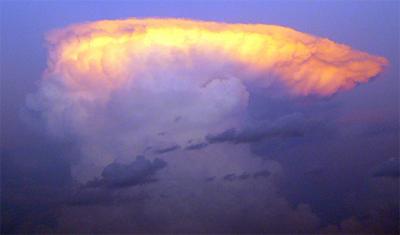Cooler Days, Warmer Nights
In the story of the climate, pollution and its effect on clouds matters.Pollution can decrease the daily temperature range via larger high clouds left after a thunderstorm, spreading out across the sky and looking like anvils. These clouds cast shadows and cool the Earth during the day but trap heat like a blanket at night. For late afternoon thunderstorms in summers, pollution can cause clouds to last long into the night rather than dissipate, causing warmer nights. Accounting for how pollution affects storm clouds could affect the ultimate amount of warming predicted for the Earth in the next few decades.
In a new study published in the Proceedings of the National Academy of Sciences, a team led by Dr. Jiwen Fan at Pacific Northwest National Laboratory revealed how pollution causes thunderstorms to leave behind larger, deeper, longer lasting clouds. The results show how pollution affects climate warming. Researchers had thought that pollution causes larger and longer-lasting storm clouds by making thunderheads draftier through a process known as convection (see sidebar, Convection). The team showed that pollution instead makes clouds linger by decreasing the sizes of water and ice particles. The difference will affect how scientists represent clouds in climate models.
"This study reconciles what we see in real life to what computer models show us," said Fan, a PNNL atmospheric scientist. "Observations consistently show taller and bigger anvil-shaped clouds in storm systems with pollution, but the models don't always show stronger convection. Now we know why."
The researchers started with cloud data from three Atmospheric Radiation Measurement (ARM) Climate Research Facility locations that differ in how polluted, humid and windy they typically are: the tropics in the western Pacific, southeastern China and the Great Plains in Oklahoma. They compared real-life summer storm clouds to a computer model that zooms deep into simulated clouds. The model included physical properties of the cloud particles as well as the ability to see convection. Most models run in days or weeks, but the simulations in this study took up to six months, showing the complexity and detail of the information. Lastly, the team estimated how much warming or cooling the storm clouds contributed. Overall, the polluted clouds cooled the day and warmed the night, decreasing the daily temperature range.

